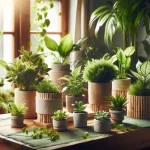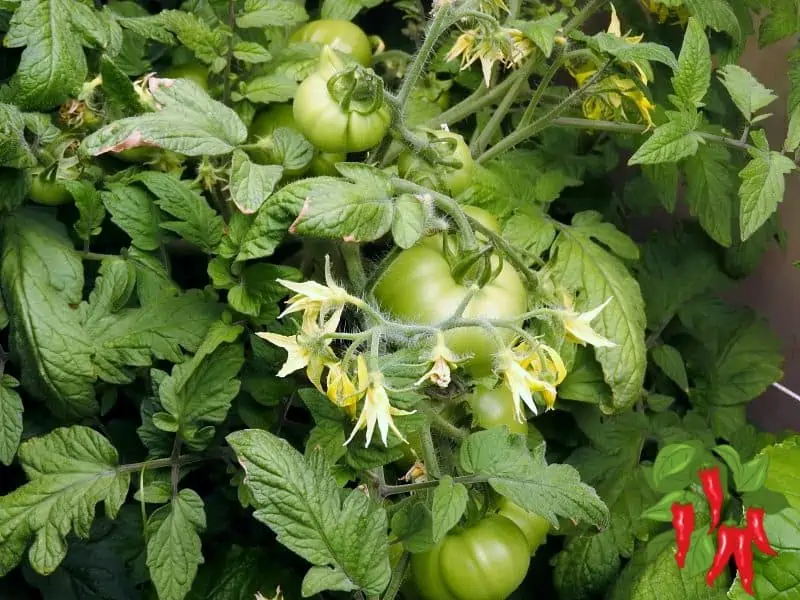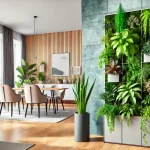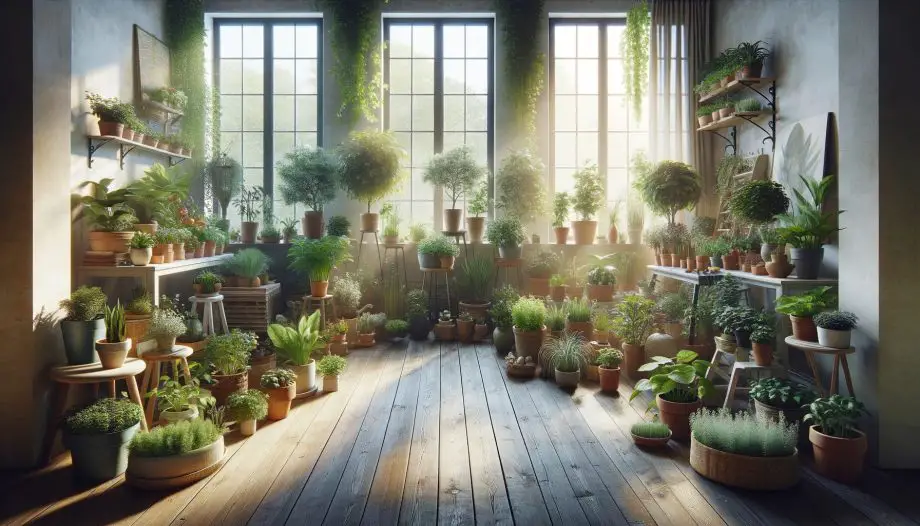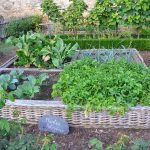This post may contain affiliate links. If you buy something from one of our links we may earn a commission. Thanks
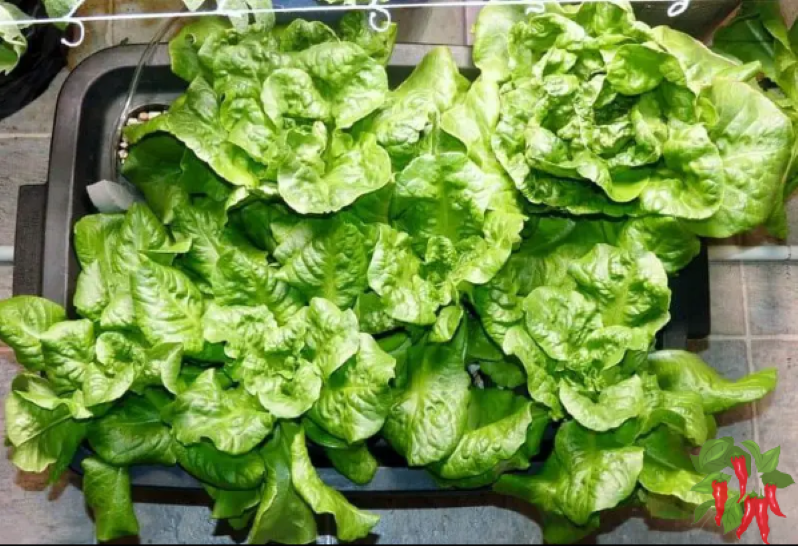
Get started with hydroponic gardening for apartments! It’s an easy, water-efficient way to grow fresh greens right in your home. Learn how today!
Think you can’t grow fresh veggies in your apartment? Think again! Hydroponic gardening for apartments is revolutionizing the way urban dwellers can farm right in their living rooms.
Read on to discover how you can cultivate delicious greens without a traditional garden.
Easy Hydroponic Gardening For Apartments:
Welcome to the world of easy hydroponic gardening for apartments!
If the idea of growing fresh, delicious greens in your apartment intrigues you, then you’re in for a treat.
If you are like most people, you don’t have a lot of space in your apartment for a garden.
Hydroponic gardening for apartments is a great way to get around this problem!
This guide will take you through a simple and effective way to cultivate your favorite plants without needing soil or a backyard. Let’s dive in!
An Introduction to Hydroponic Gardening
Have you ever dreamed of cultivating your own garden but lack the yard space to do so? Welcome to the world of hydroponic gardening!
This innovative method of gardening allows you to grow plants without the need for soil.
Using nutrient-rich water and a specially designed system, you can enjoy gardening no matter where you live.
Whether you’re a seasoned gardener looking to try something new or an urban dweller yearning for fresh greens, hydroponic gardening offers a fascinating way to grow your favorite plants.
What is Hydroponic Gardening?
Hydroponic gardening refers to the process of growing plants without soil, using nutrient-rich water to deliver the necessary minerals directly to the plants’ roots.
In traditional gardening, the soil acts as a nutrient reservoir, but in hydroponics, you control the nutrient mix, making it an efficient and responsive way to nurture plants.
There are several types of hydroponic systems, each with its unique approach, including the DWC (deep water culture), aeroponics, and the Kratky method, among others.
Benefits of Hydroponic Gardening
One of the standout benefits of hydroponic gardening is the efficient use of water.
It generally consumes less water than traditional soil gardening because the system recirculates water, leading to less waste.
Additionally, hydroponic gardening offers control over the nutrients, allowing for precise adjustments, leading to potentially faster growth and healthier plants.
Space efficiency is another perk, making hydroponic gardening particularly appealing for those in urban areas or apartments where outdoor gardening space is limited.
From beginners to advanced gardeners, hydroponic gardening opens up a new frontier of possibilities.
You’ll not only enjoy the fresh taste of homegrown produce but also the rewarding experience of watching your plants thrive in this soil-less world.
Hydroponics is the process of growing plants in water instead of soil. This method has many advantages, including:
• You can grow plants anywhere, even if you don’t have any outdoor space
• Hydroponic gardens use less water than traditional gardens
• Hydroponic gardens are more efficient because all the nutrients the plants need are delivered directly to them.
• You do not need any messy soil inside your home.
How To Build A Simple Hydroponic System
We are going to build a Kratky system for growing lettuce or greens. This is a simple passive hydroponic system that needs no electricity.
It works great for lettuce or other leafy greens but not for large plants like tomatoes or peppers.
Lettuce and herbs need much less light than tomatoes but you will still need to find a place that gets some sunlight or where you can add a fluorescent or LED light.
If you are interested in starting a hydroponic garden, there are a few things you will need to get started using the Kratky method:
You will need:
• A container to use as a reservoir. Any plastic storage bin with a lid will work just fine. I used a 10-gallon Rubbermaid tote for mine.
• Pots to grow your plants in, plastic net pots work best for this.
• Hydroponic growing media such as perlite, or hydroton.
• Nutrient solution. Follow mixing directions. More is not better!
Once you have all of your supplies, you will need to set up your hydroponic system. There are many different ways to do this, but one of the simplest hydroponic systems is the Kratky method.
There are 2 ways you can set this up. You can use 3-inch net pots and cut holes in the lid of the tote to fit them in. Here is what mine looks like.
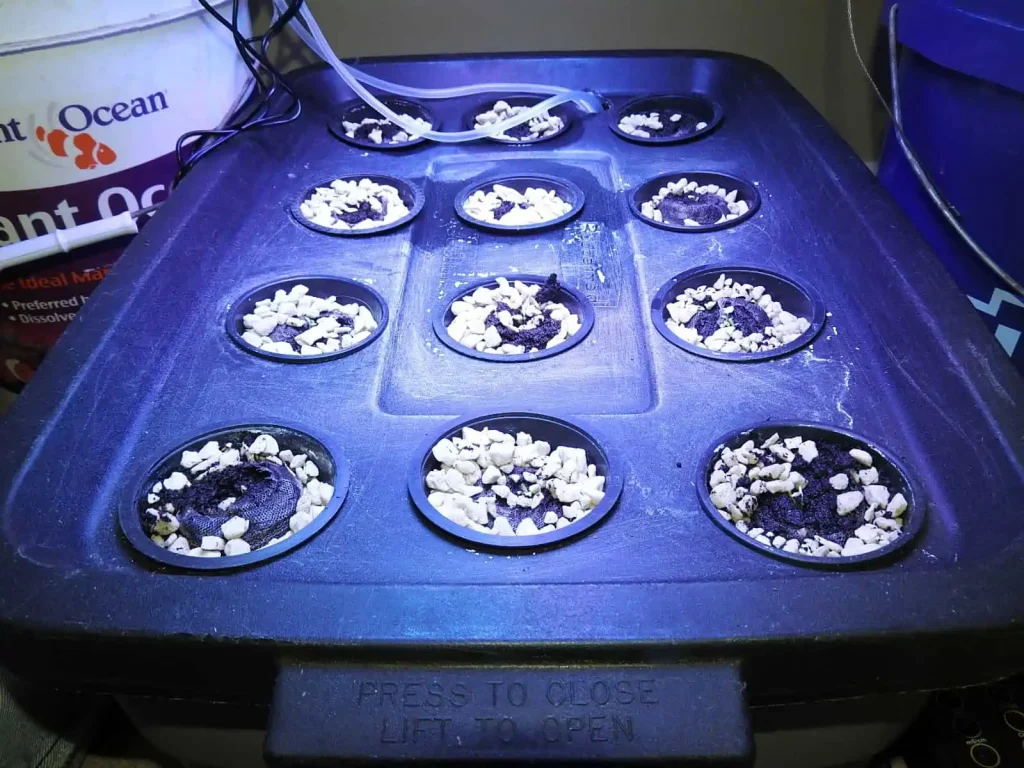
Or you can use a piece of styrofoam that just fits inside your tote. You will need to cut holes to fit your plants or net pots through.
The advantage of using net pots in a lid instead of a styrofoam raft is that it is easy to move plants around.
This system is very flexible so you can grow only one plant or several at a time. A lot will depend on the size of your tote but your plants should be 8-12 inches apart.
I recommend buying transplants if you are new to growing or if you are more experienced you can grow your own from seed.
If you buy transplants you will want to gently wash off as much soil as you can from the roots.
Then you will place the roots in a net pot filling it in with grow medium.
I started my own lettuce seeds in jiffy pellets and then placed them in the net pots.
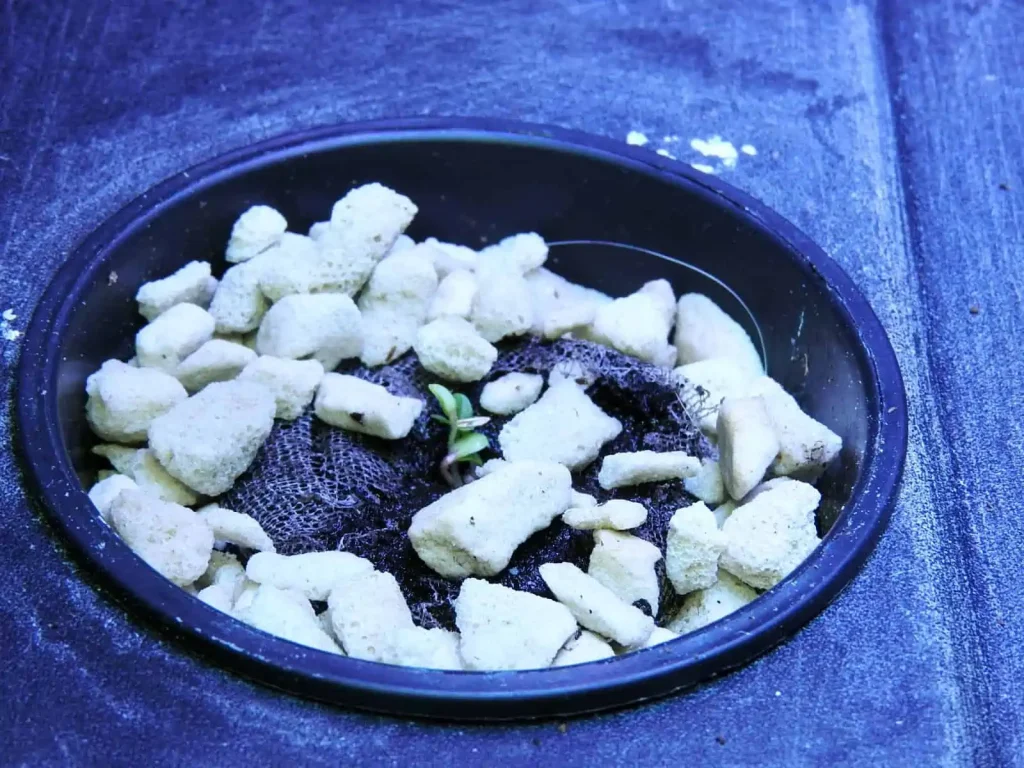
Here they are a few weeks later. I have 12 plants in my Kratky system. Six are leaf lettuce and 6 are Buttercrunch.
The leaf lettuce will be done in 45 days but you can start harvesting leaves much sooner.
The Buttercrunch is a semi-heading lettuce that takes about 60 days. Once the leaf lettuce is gone there will be more room for head lettuce to grow.
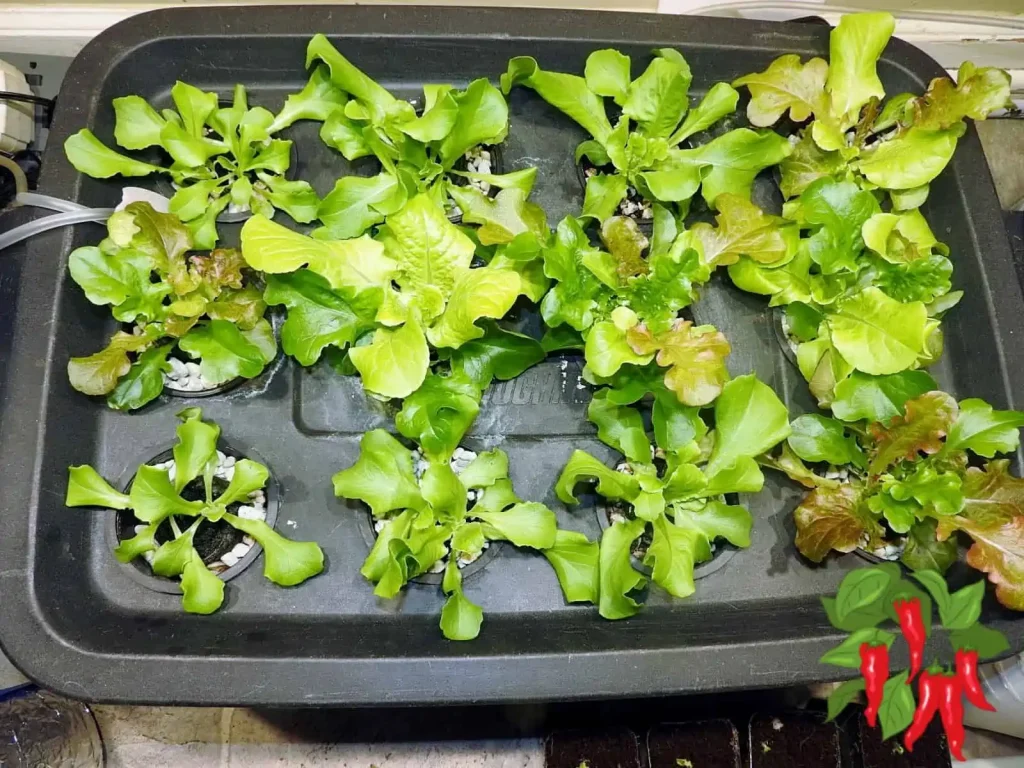
Here are some roots. I added a wick to each pot but this is not really necessary.
If you want you can add an airstone to your tote but again not required.
However, adding an airstone will result in better growth. Once you add an air stone this is technically DWC (deep water culture).
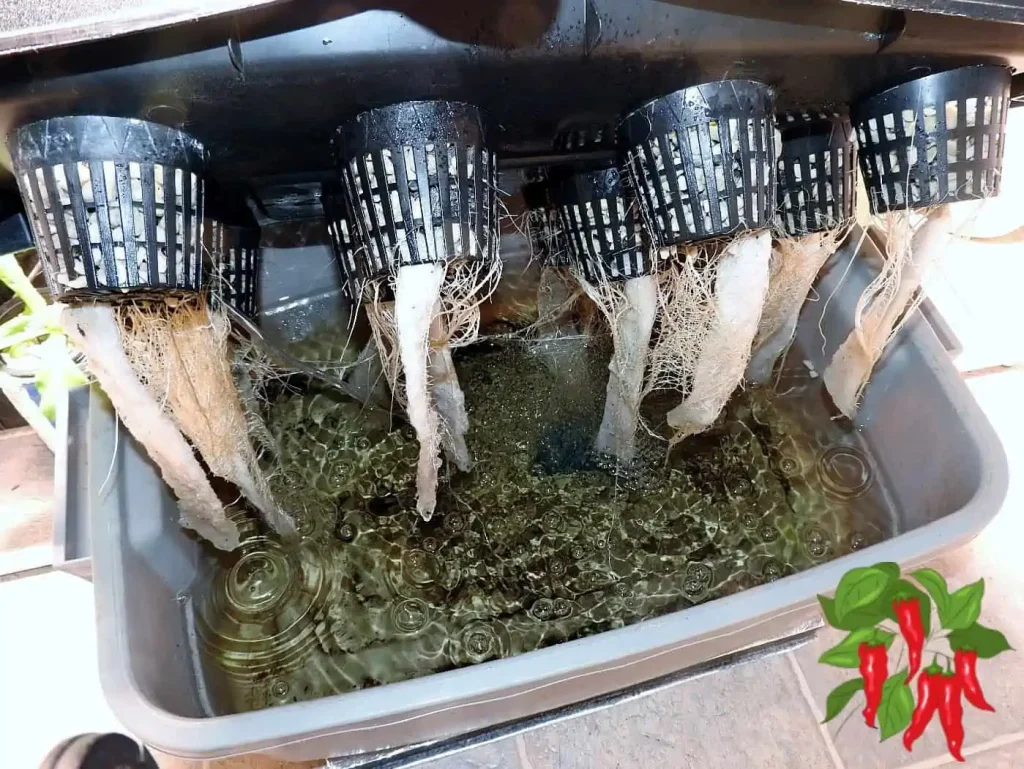
Add your transplanted plants in net pots to the lid or through holes in the styrofoam raft.
If you are careful you may be able to make small holes in the raft that are large enough to get the roots through but won’t let the whole plant fall through.
Fill your reservoir with hydroponic nutrient solution. It should be close to the tops of the net pots.
As your plants grow the water level will drop. The roots above the waterline supply oxygen to the plant while the roots in nutrient solution feed the plant.
Your plants should be done before the water is all gone. This is why this system works best for fast-growing plants.
With the Kratky method, you don’t replace the water as it goes down because it would cover the plant’s air roots. But if you decide to use an airstone you can safely top up your reservoir.
That’s really all there is to it! Hydroponic gardening is a great way to grow plants in your apartment, even if you don’t have any outdoor space give it a try today!
Steps to Set Up Your Kratky Hydroponic System In A Nutshell
Here’s what you will need:
1. Containers:
Type: Plastic storage bins with lids are generally suitable, as they are watertight and easy to modify. Containers like a 10-gallon Rubbermaid tote are commonly used.
Size: Your plants should be spaced 8-12 inches apart, so choose a container that fits your desired number of plants. A larger container means more plants, but it also requires more nutrients and space.
Shape: Containers with a wide, flat bottom work best for distributing the nutrient solution evenly among the plants.
2. Nutrients:
Nutrient Solution: You must choose a nutrient solution formulated specifically for hydroponics. It will contain all the essential minerals your plants need.
Mixing Instructions: Follow the manufacturer’s instructions when mixing the nutrient solution. More is not always better; incorrect concentrations can harm the plants.
pH Levels: Monitor and maintain proper pH levels in the nutrient solution to ensure that nutrients are available to the plants. A pH range of 5.5 to 6.5 is usually optimal for most plants.
3. Additional Accessories:
Net Pots: Plastic net pots work best for holding plants. Use 3-inch net pots.
Growing Media: Choose inert media like perlite, grow stones, or hydroton to support the plants’ roots. With the right choices, your hydroponic system will be off to a great start!
ph pen and TDS meter: You can find cheap ones on Amazon. You need these to make and monitor your nutrient solution.
Steps to Set Up Your Kratky Hydroponic System
Setting up a Kratky hydroponic system is simple and can be done with basic supplies. Here’s a step-by-step guide:
1. Prepare Your Container:
Cut holes in the lid of the tote to fit your net pots, or prepare a piece of styrofoam that fits inside your tote, cutting holes to fit your plants or net pots through.
The advantage of using net pots in a lid instead of a styrofoam raft is that it’s easy to move plants around.
2. Plant Your Seeds or Transplants:
If you buy transplants, wash off as much soil as you can from the roots.
Place the roots in a net pot, filling it in with grow medium, or start seeds in jiffy pellets and place them in the net pots.
3. Prepare Nutrient Solution:
Mix the nutrient solution according to the instructions and fill your reservoir close to the tops of the net pots. I recommend 500 ppms for young plants and up to 1000 ppms for larger plants.
4. Place Plants in the System:
Add your transplanted plants in net pots to the lid or through holes in the styrofoam raft. Be careful when making holes in the raft to prevent the plants from falling through.
5. Monitor Water Levels:
As your plants grow, the water level will drop, leaving some roots above the waterline to supply oxygen and others in the nutrient solution to feed the plant.
With the Kratky method, don’t replace the water as it goes down. If you decide to use an airstone, you can safely top up your reservoir.
6. Harvest Your Plants:
Harvest your plants once they’ve reached their growth potential. Timing varies depending on the plant type.
By following these steps, you can set up a Kratky hydroponic system easily in your apartment, enjoying fresh produce right at home!
Hydroponic Gardening For Apartments FAQ:
Got questions about hydroponic gardening for apartments? You’re not alone! The world of hydroponics is fascinating, and it’s normal to have a few queries before getting started.
In this FAQ section, we’ll answer some common questions to clear up any confusion and get you growing in no time!
Q: Can I grow any type of vegetable with the Kratky method?
A: The Kratky method works best with fast-growing plants like lettuce and herbs. It may not be suitable for larger plants like tomatoes or peppers.
However, adding an airstone allows you to refill the reservoir and grow longer maturing plants but technically adding an airstone makes it a DWC system and not a true Kratky system.
Q: Do I need to add more water to the system as the plants grow?
A: With the Kratky method, you don’t replace the water as it goes down. However, as mentioned if you use an airstone, you can safely top up your reservoir.
Q: Is sunlight necessary for hydroponic gardening in my apartment?
A: Sunlight is beneficial but not essential. However light itself is essential. You can also use fluorescent or LED lights to provide the necessary light for plant growth.
Q: Can I move my plants around in the Kratky system?
A: Yes, the flexibility of using net pots in a lid makes it easy to move plants around within the system.
Hydroponic Gardening For Apartments Final Thoughts
If you’re living in an apartment and don’t have a lot of space, hydroponic gardening at home might be the perfect solution for you.
Hydroponics allows you to grow plants in water without soil, so it’s great for small spaces.
There are many different types of hydroponic systems so read this article and you can choose the one that best suits your needs.
Here is another good article on growing Kratky lettuce
To summarize:
• Hydroponics is the process of growing plants in water instead of soil.
• Hydroponic gardens use less water than traditional gardens.
• Hydroponic gardens are more efficient because all the nutrients the plants need are delivered directly to them.
• Hydroponic gardening is a great way to grow plants in your apartment, even if you don’t have any outdoor space.
Give it a try! You may be surprised at how much you enjoy growing your own vegetables and herbs.
Visit my Amazon Influencer Page for videos and gardening products Grow Your Own Garden

